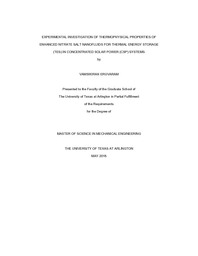
ATTENTION: The works hosted here are being migrated to a new repository that will consolidate resources, improve discoverability, and better show UTA's research impact on the global community. We will update authors as the migration progresses. Please see MavMatrix for more information.
Show simple item record
| dc.contributor.advisor | Donghyun, Shin | |
| dc.contributor.advisor | Seiichi, Nomura | |
| dc.creator | Eruvaram, Vamsi Kiran | |
| dc.date.accessioned | 2018-06-05T18:55:12Z | |
| dc.date.available | 2018-06-05T18:55:12Z | |
| dc.date.created | 2018-05 | |
| dc.date.issued | 2018-05-16 | |
| dc.date.submitted | May 2018 | |
| dc.identifier.uri | | |
| dc.identifier.uri | http://hdl.handle.net/10106/27473 | |
| dc.description.abstract | The main source for energy production right now is from thermal, nuclear energy. But in the near future we might have crisis of coal so we need alternate renewable source for energy production the solution for that is sun, since solar energy is renewable and abundantly available. Concentrated solar power (CSP) technologies is one of the best solution to overcome this energy crisis, because it works from solar energy. If the CSP is incorporated with thermal energy storage (TES) we can produce energy even during night. TES with 15-hour storage capacity (Gemasolar) is already commercialized to operate a CSP plant for 24 hours a day. When the sunlight is concentrated by mirrors into a small focal point, a heat transfer fluid transfers the collected heat to a turbine or an engine to produce electricity and any surplus heat to a TES unit for later use. Typical CSP plants used two different materials for heat transfer fluid and TES, and thus several heat exchangers were necessary between HTF and TES. These heat exchangers can cause a significant temperature drop due to the thermal heat transfer losses because of this efficiency of the cycle gets reduced. Thermo physical properties of the HTF are one of the important factors in transferring thermal energy. Different specific heat measurement techniques have been determined in this work for finding theoptimum method for Cp measurement. One of the promising chemicals for the purpose of HTF is mixture of molten salts. However, low thermal properties of molten salts, such as specific heat capacity (Cp around 1.5 kJ/kg°C) constrains thermal performance of CSP systems. Recently, many studies have been conducted to overcome this difficulty, by adding minute concentration of nanoparticles. In this work, the selected molten salt eutectic is a mixture of LiNO3– NaNO3 by composition of (54:46 mol. %) plus dispersing Aluminium oxide (Al2O3) nanoparticles with 40nm particle size. A standard differential scanning calorimeter (SDSC) is employed to measure the Cp of pure and nanomaterial samples. The results from this work shows a 18.3% Cp enhancement. Economic analysis of CSP has been performed to know the effect of impact of specific heat enhancement on CSP by using System Advisor Model as base tool for simulation. | |
| dc.format.mimetype | application/pdf | |
| dc.language.iso | en_US | |
| dc.subject | Thermal energy storage | |
| dc.subject | Specific heat | |
| dc.subject | System advisor model | |
| dc.title | EXPERIMENTAL INVESTIGATION OF THERMOPHYSICAL PROPERTIES OF ENHANCED NITRATE SALT NANOFLUIDS FOR THERMAL ENERGY STORAGE (TES) IN CONCENTRATED SOLAR POWER (CSP) SYSTEMS | |
| dc.type | Thesis | |
| dc.degree.department | Mechanical and Aerospace Engineering | |
| dc.degree.name | Master of Science in Mechanical Engineering | |
| dc.date.updated | 2018-06-05T18:57:19Z | |
| thesis.degree.department | Mechanical and Aerospace Engineering | |
| thesis.degree.grantor | The University of Texas at Arlington | |
| thesis.degree.level | Masters | |
| thesis.degree.name | Master of Science in Mechanical Engineering | |
| dc.type.material | text | |
Files in this item
- Name:
- ERUVARAM-THESIS-2018.pdf
- Size:
- 1.828Mb
- Format:
- PDF
This item appears in the following Collection(s)
Show simple item record


